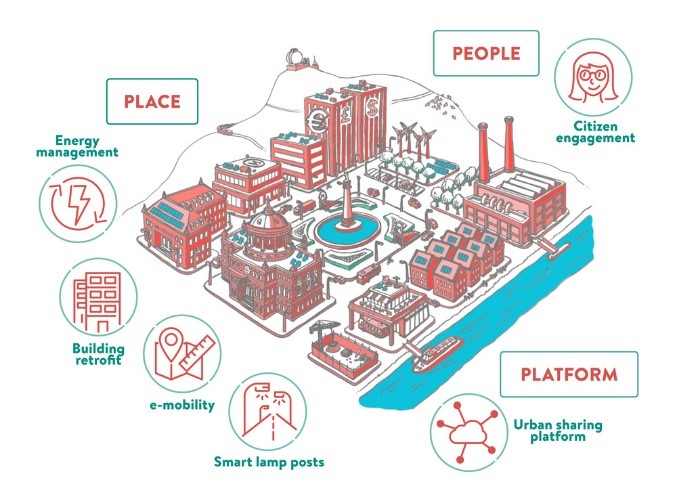
Connected public spaces

New possibilities for cities through connected systems
Public urban spaces have experienced a change in meaning in the age of technological interconnectedness. Due to the development of intelligent and networked technologies and services, new opportunities have become available for city dwellers. Through these technologies, important information can be collected and subsequently utilised to test and experiment with urban pilot projects.
This topic is relevant for city administrations (integrated urban development), OEMs, real estate companies, retail, transport, research institutes, companies and industry.
Smart connectivity for public spaces
The cities of the future are faced with the challenge of improving the quality of life for their residents, particularly in the context of increasing urbanization. Public space plays an important role here and has thus become a central topic within urban planning circles.
Objective
The objective of the smart digital networking of public spaces is not only to improve accessibility, utilization or aesthetics of public spaces, but also help better understand the behavior of the people living in the city through collection of dynamic data (pedestrians, mobility behavior, environmental data, etc.). Continuous evaluation can serve as a basis for the further development of the smart networking of public spaces, in terms of meeting the needs of the city residents and increasing the attractiveness of public spaces.
Major opportunities for new technologies development
Public spaces offer new opportunities as innovative platforms for development of smart technological solutions and services. This presents city dwellers with new opportunities to better understand and actively shape their own urban spaces.
Sustainability
With the help of innovative technologies, smart module systems generate their own energy (mainly solar) and are characterized by exceptionally high efficiency. Complemented by its socially added value, such interventions can significantly improve sustainability of public spaces.
Modular offer
Smart and innovative technologies offer multiple potential uses. The modularity of the technologies allow coupling of core modules with additional modules to adapt and expand in accordance to the needs of the city.
Morgenstadt Partner Solutions
- Smart lighting
- Smart public furniture
- Sensor infrastructures (e.g. waste disposal)
- Information augmented reality systems
- Data-back end and front-end applications
Reference Projects
Sharing Cities - Building smart cities together
The project Sharing Cities aims to investigate the role of digital technology in cities and to clarify how all urban residents can benefit from this transformation process and actively contribute to it at the same time.
In three strategically important locations - London, Lisbon and Milan - the effectiveness of new technologies is demonstrated by means of improved urban mobility structures, increased energy efficiency of buildings and local pollution emission reductions.
Sharing Cities embodies the vision of a more agile and more collaborative smart city market that facilitates implementation of intelligent solutions in European cities with increasing speed and scope. The project aims to encourage civil society to actively participate in the transformation of their municipalities. Together, a more dynamic, livable, competitive, and resource-efficient city will be created.
Through the exchange of solutions, practices, experiences and results as well as the improvement of urban data and infrastructure management, the project co-creates an improved living environment while reducing energy costs.
Urban sharing platform
This platform is used to manage collected information from various sources. It is built according to Open-Data principles and standards.
Smart lamp posts
These lamps demonstrate a holistic solution comprising various smart city technologies: a lamp is connected to other intelligent service structures (for example, charging stations, intelligent parking stations, traffic monitoring systems, data management systems, Wi-Fi, etc.).
Citizenship
Development of new approaches and tools to facilitate public interaction with—as well as their active participation in the shaping of—the smart city
E Mobility
Multiple modules linked to eMobility (electric bicycles or car-sharing systems, parking sensors to assist with parking management, etc.) can be integrated during the installation of EV charging stations to demonstrate a holistic approach to creating low-emission mobility solutions for the city.
